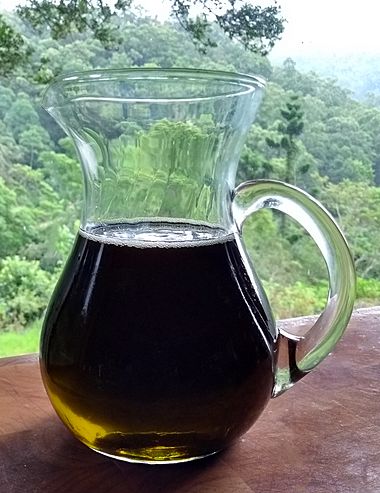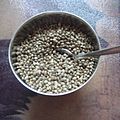Hemp oil facts for kids
Hemp oil, also known as hemp seed oil, is a special oil made by pressing seeds from the hemp plant. When it's made without heat (cold-pressed) and not processed much (unrefined), it looks dark to light green and has a nutty taste. The darker the oil, the more it tastes like grass. It's important not to mix up hemp oil with hash oil, which is a different oil made from the cannabis flower and contains tetrahydrocannabinol (THC), a substance that can affect your mind. Hemp oil has very little to no THC.
Contents
What is Hemp Oil?
Refined hemp seed oil is clear, has no color, and very little taste. This type is mostly used in products for your body, like lotions or creams. Industrial hemp seed oil is used in many different things, such as lubricants, paints, inks, and even some plastics. You can also find hemp seed oil in soaps, shampoos, and cleaning products.
This oil is special because it has a good balance of important fats called omega-6 and omega-3 essential fatty acids. These are fats your body needs but cannot make itself. Hemp oil can also be used to make biodiesel, which is a type of fuel.
How Hemp Oil is Made
Hemp seed oil comes from specific types of Cannabis sativa plants. These plants are grown to have very small amounts of tetrahydrocannabinol (THC), which is the main part of the cannabis plant that makes people feel "high."
To make the oil, the seeds are cleaned very carefully, usually to 99.99% purity, before they are pressed. The hemp seed itself does not contain THC. However, tiny amounts of THC might get into the oil if small bits of the plant stick to the seeds during the making process.
Modern ways of making hemp seed oil, especially in places like Canada, have successfully lowered THC levels since 1998. Regular tests show that THC levels in Canadian hemp seed oil are usually so low they can barely be detected. Many countries have strict rules about how much THC can be in food products.
Hemp Oil and Nutrition
About half the weight of a hempseed is edible oil. This oil is rich in polyunsaturated fat, which is a healthy type of fat. It includes important fats like omega-6 fatty acids (such as linoleic acid) and omega-3 fatty acids (like alpha-linolenic acid). Your body needs both linoleic acid and alpha-linolenic acid, but it can't make them, so you have to get them from food.
Hemp seed oil also contains some monounsaturated fat and a small amount of saturated fat. Like all oils and fats, hemp seed oil provides energy for your body.
Compared to many other cooking oils, hemp seed oil has less saturated fat and more healthy polyunsaturated fat. It has a low smoke point, which means it starts to smoke and break down at lower temperatures. Because of this, it's not good for frying food. Instead, it's mostly used as a food oil, like in salad dressings, or as a dietary supplement to add healthy fats to your diet.
Hemp Oil for Wood
Hemp oil is known as a "drying oil." This means it can turn into a solid form when exposed to air. Because of this special quality, hemp oil is used by itself or mixed with other things to finish wood. It can soak into wood and help protect it, or be used as a varnish to give wood a shiny, protective layer. It's also used in oil paints to bind the colors together and in putty to make it more flexible and harder.
Gallery
-
An experimental batch of hemp oil produced in bottles in Buryatia
Society and Culture
In December 2021, the public transport system in Berlin, Germany, did something interesting: they offered passengers edible hemp tickets!
See also
 In Spanish: Aceite de cáñamo para niños
In Spanish: Aceite de cáñamo para niños





